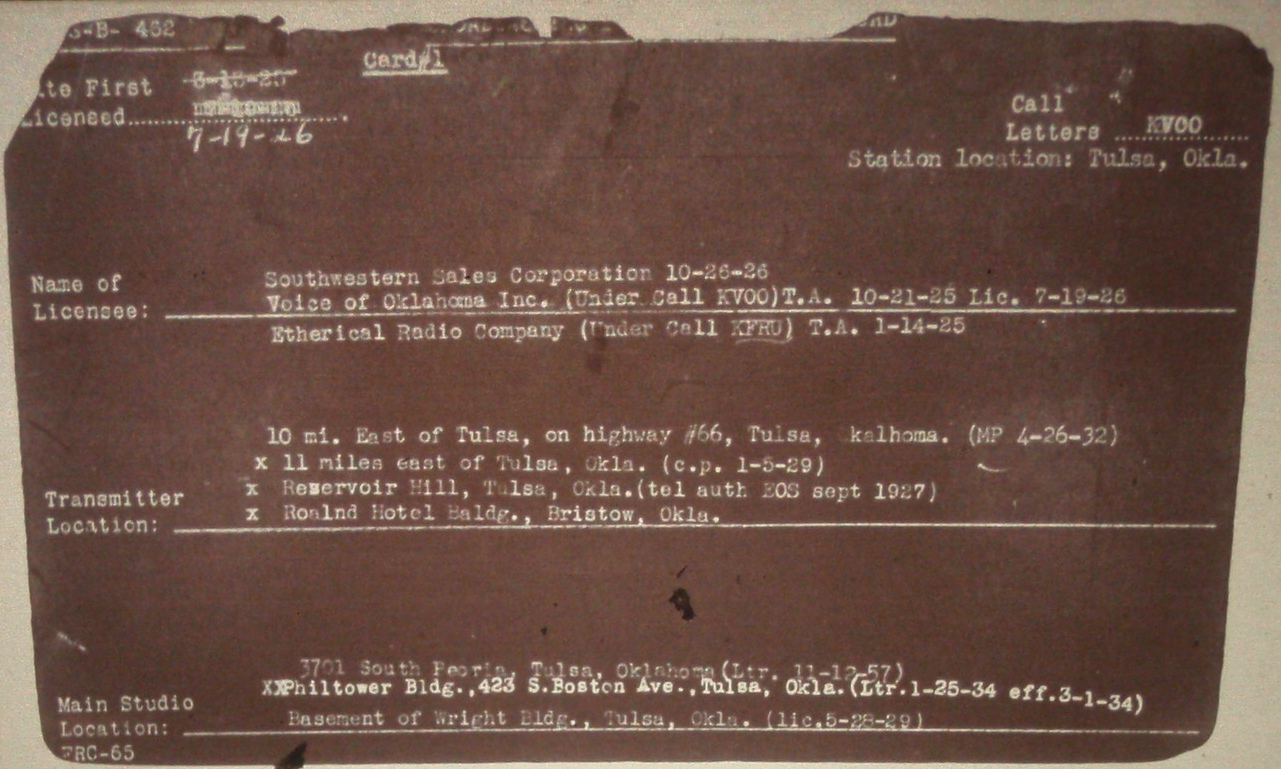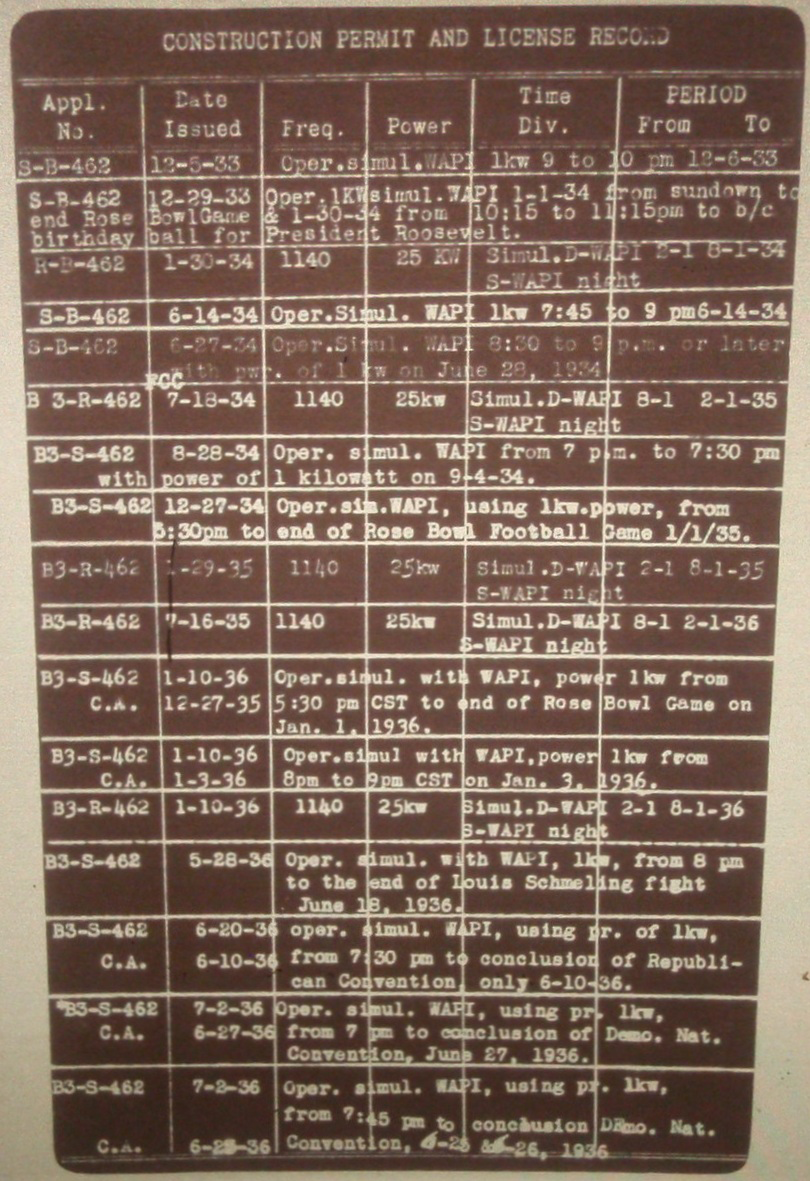Tulsa Media: May 2019 Archives
If you click around the FCC radio station database, you will find some interesting stuff.
Here's the FCC database entry for KFAQ, AM 1170.
If you'll click on the "Links & Maps" tab, then click on "History Cards for KFAQ (PDF)," you'll get a scan of the FCC's record cards for the station known for most of its history as KVOO, from its beginnings in 1925 until the FCC began using computers in 1980 -- call letters, studio locations, transmitter locations, hours of operation, transmitter power, and special permissions.

The most interesting thing I learned from these cards was that in its early years, KVOO shared its frequency with WAPI in Birmingham, Alabama. In the early years, the two stations had to take turns broadcasting, despite the low power and the significant distance. In 1931, they were permitted to broadcast simultaneously during daylight hours, but still had to split time at night, except for important live broadcasts, in which they reduced power and broadcast simultaneously -- President Roosevelt's radio addresses, the Rose Bowl, the 1936 Joe Louis - Max Schmeling fight, the 1936 Republican and Democratic National Conventions, 1936 pre-election party broadcasts from the Republicans, Democrats, and the Union Party, 1938 Oklahoma primary election returns, and the 1938 dedication of the Will Rogers Memorial.

On November 21, 1933, KVOO upped its power from 5 kW to 25 kW, a change which would result, about 10 weeks later, in a major career break for Bob Wills and His Texas Playboys, as their maiden broadcast on the station prompted enthusiastic audience response from as far away as Oakland, California. That earned the band a show on the station, and station manager Bill Way refused to cave to the threats of W. Lee "Pappy" O'Daniel, who had managed to get the Playboys blackballed from several stations. That higher broadcast power made Bob Wills a regional star and made Tulsa his adopted hometown.
It was in 1938 that KVOO began broadcasting at night with a directional antenna to avoid interference with other stations on the same frequency. I haven't been able to find a guide to the abbreviations used on these cards, but it appears that the shift from 25 to 50 kW happened on August 5, 1941 (p. 15), although (p. 30) the equipment from 50 kW was installed on July 7, 1930.
Some highlights:
Ownership (page 2): First licensed on July 19, 1926, but shows operation under T. A. (temporary authorization?) from January 14, 1925, broadcasting as KFRU, licensed to the wonderfully-named Etherical Radio Company. Voice of Oklahoma, Inc., changed the name to KVOO and took over the T. A. as of October 21, 1925. Southwestern Sales Corp. took over as of October 26, 1926.
Transmitters (page 2): The transmitter location was originally at the Roland Hotel in Bristow, then Reservoir Hill, then 11 miles east of Tulsa, and finally 10 miles east of Tulsa, "on highway #66," as of April 26, 1932.
Main Studio Location (page 2): First listed is the Basement of the Wright Bldg. (lic. 5-28-29). Next is the Philtower Bldg (Ltr. 1-25-34 eff. 3-1-34) -- during that gap, at midnight on February 9, 1934, is the first KVOO broadcast of Bob Wills and His Texas Playboys. A letter dated 11-12-57 noted the switch to the new KVOO radio and TV studios at 3701 S. Peoria.
Frequencies and power (page 3): Originally broadcast on 800 kHz at 1 KW, from 4-22-27 to 6-1-27, then on 860. Nothing is listed until 11-11-28, when it switches to 1140 kHz, which was KVOO's frequency until the North American Regional Broadcasting Agreement (NARBA) went into effect on March 29, 1941, requiring KVOO to move up by 30 kHz to the 1170 frequency it has had ever since.
MORE:
Here's the FCC database's list of all licensed AM stations within 100 miles of KFAQ transmitters
Google Books link to KVOO references in San Antonio Rose, Charles R. Townsend's bio of Bob Wills.
STILL MORE (2020/02/03):
The Tulsa station at 1300 kHz, known these days as "The Buzz," was known for most of its existence (1938-1968) as KOME (Oklahoma's Magic Empire) and was an affiliate of ABC. It was KCNW (Country 'N' Western) from 1968 - 1973. San Antonio Broadcasting (owners of WOAI) bought the station in 1973, renamed it to KXXO, and turned it into Tulsa's first news-talk station, a CBS News affiliate, with Hal O'Halloran's SportsTalk every night from 6:20 to 7:00. San Antonio Broadcasting became Clear Channel Communications in 1979, and KXXO took the call letters of FM sister station KMOD in 1980. (It later became KBBJ -- Big Band & Jazz -- and then KAKC, reviving the call letters and music of Tulsa's pioneer rock & roll station.) The original transmitter was at 3904 S. Newport (now a residential part of Brookside). From 1946 to 1969, the KOME studio was at 724 S. Main, on the second floor above Harrington's Clothing; in 2009 Tulsa TV Memories' Mike Ransom and former NBC News anchor Jim Hartz did some urban exploration and photographed the old KOME studios, unchanged in four decades. (The entire building has since been redeveloped as apartments.)